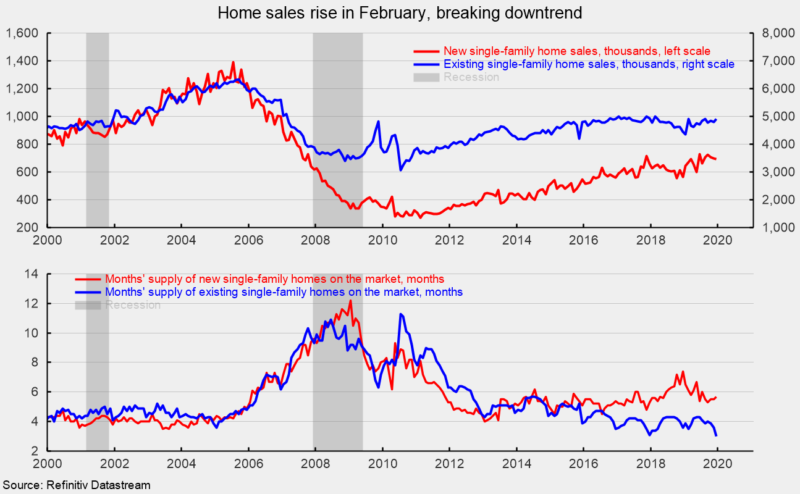New- and Existing-Home Sales Diverge in December

Sales of new and existing single-family homes diverged in December, with new-home sales falling 0.4 percent and sales of existing homes rising 3.6 percent. While both categories have achieved significant rebounds from their post-recession lows, recent data suggest the two categories may have diverging short-term momentum (see top chart). Despite diverging short-term momentum, the outlooks for both segments remain cautious.
For new single-family homes, sales came in at 694,000, down from 697,000 in November. Despite the drop, sales are still up 23.0 percent from a year ago. Across the four regions, sales were down 11.8 percent to 30,000 in the Northeast and down 15.4 percent to 347,000 in the South, the largest region by volume. Sales were up 10.1 percent to 76,000 in the Midwest, and up 31.0 percent to 241,000 in the West. From a year ago, sales were up 11.1 percent in the Northeast, 16.9 percent in the Midwest, and 99.2 percent in the West but down 1.1 percent in the South.
Total inventory of new single-family homes for sale rose 1.6 percent to 327,000 in December, pushing the months’ supply (inventory divided by the annual selling rate times 12) to 5.7, up from 5.5 months in November. For new single-family homes, months’ supply has been holding above five, a somewhat elevated level, since December 2017 (see bottom chart).
Sales of existing homes rose 3.6 percent in December to a 5.54 million seasonally adjusted annual rate. Sales are up a robust 10.8 percent from a year ago but remain essentially in a flat trend, about equal to 2017 levels. Sales are well below the all-time peak of 7.25 million in 2005 and well above the low of 3.45 million in July 2010.
Sales rose in three of the four regions tallied: they rose 5.7 percent in the Northeast, putting sales 8.8 percent above year-ago levels; sales gained 5.4 percent for the month in the South and are 12.4 percent above the December 2018 rate; and sales increased 4.6 percent in the West, putting that region’s sales rate 10.7 percent above the year-ago pace. Sales were down 1.5 percent for the month in the Midwest but are 9.2 percent above the year-ago level.
Sales in the market for existing single-family homes, which account for just under 90 percent of total existing-home sales, rose 2.7 percent in December, coming in at a 4.92 million seasonally adjusted annual rate (see top chart). From a year ago, sales are up 10.6 percent. Sales were up across three of the four regions: the Northeast saw a 5.1 percent gain, putting sales 8.8 percent above year-ago levels; sales rose 4.5 percent for the month in the South and are up 11.9 percent versus a year ago; and sales increased 4.1 percent in the West, putting sales 11.0 percent above the year-ago pace. Sales were down 2.4 percent for the month in the Midwest but are 8.9 percent above the year-ago level. Single-family sales have recovered from a dip in selling that occurred from early 2018 through early 2019 but remain about on par with the selling pace for much of 2017.
Total inventory of existing single-family homes for sale declined 15.9 percent to 1.22 million in December, the smallest inventory available in 40 years. That puts the months’ supply (inventory times 12 divided by the annual selling rate) at 3.0 versus 3.6 in the prior month. The drop in months’ supply has brought the figure back to the ultra-low levels of late 2017 and the range that prevailed during the early 2000s (see bottom chart). That stands in sharp contrast to the elevated months’ supply for new homes.
Single-family housing starts and permits have been rising in recent months despite the move higher in months’ supply. Builders may be anticipating an increase in demand for new homes, given the tight supply of existing homes on the market. However, if that demand doesn’t materialize, builders may be left with excess inventory and may need to cut back sharply on construction activity.
Still, the economy overall continues to grow, albeit slowly, supported by a tight labor market, rising incomes, and strong consumer balance sheets. The main risks on the horizon are increased uncertainty from erratic trade policies, ongoing trade wars, political events including impeachment and upcoming elections, and ballooning federal deficits. Extreme uncertainty can impact business and consumer confidence and could begin to restrain economic growth.





